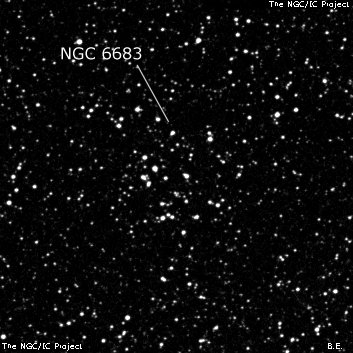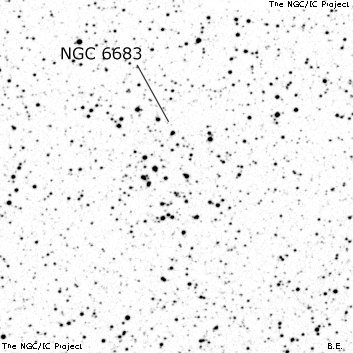NGC/IC Project Restoration Effort
(This is a very very beta version)
NGC6683


Basic Information
Location and Magnitude
Right Ascension: 18:42:12.7
Declination: -6:12:45
Constellation: SCT
Visual Magnitude: 9.4
Historic Information
Discoverer: Herschel J.
Year of discovery: 1827
Discovery aperture: 18.3
Observational
Summary description: Cl, vRi, vlC (in M. Way)
Sub-type: I2p
Corwin's Notes
=====
NGC 6683. I'm not quite sure just what JH was seeing here. His position is
that of a small cluster of stars, yet his description is at odds with this:
"A more than usually condensed portion of the enormous cluster of the Milky
Way. The field has 200 or 300 stars in it at once." Looking at the DSS, a
one-degree wide field shows clouds of stars defined by the many dust patches
and lanes in the area, but none are centered exactly at JH's position. All
that is eye-catchingly there is the small cluster. Thus -- the colon.
Consequently, realizing that this is not what JH meant to record, I've
reluctantly adopted the little group as his object. This follows almost, but
not quite, everyone else who has looked at this -- see Archinal and Hynes for
modern data and aliases and Archinal's Webb Society Monograph for a more
extensive discussion of earlier speculation.
Steve's Notes
=====
NGC 6683
17.5" (7/1/89): about 20 faint mag 13-15 stars in two converging rows in a very rich field. The edge of the "Great Rift" is just 10' W (part of dark nebula B103) with an abrupt drop off in stars!
8" (7/5/83): 10 faint stars in an elongated group over unresolved haze. The "Great Rift" is obvious just 10' W. In a rich field.
8" (7/16/82): elongated group of about 12 stars mag 11 and fainter in a rich star field.



